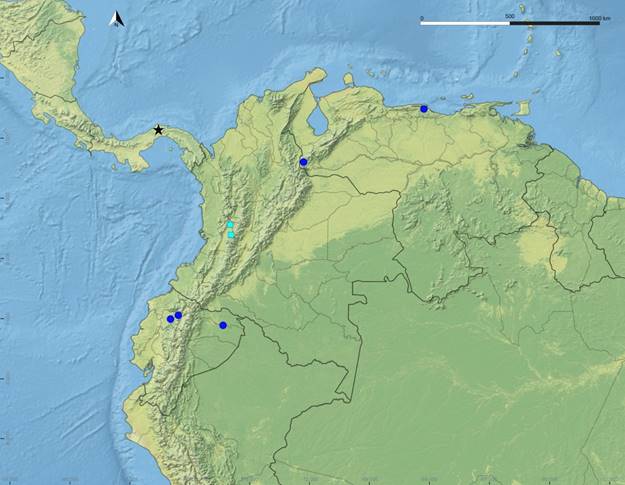Histeridae Gyllenhal, 1808 is a family of predatory beetles with about 4200 species so far described (Mazur, 2011). Omalodes Dejean, 1833, is the genus with the highest number of species (63) within Omalodini Kryzhanovskij, 1972 (Histerinae), comprising three subgenera: Omalodes (Omalodes), Omalodes (Cornillus) Lewis, 1907, and Omalodes (Diplogrammicus) Lewis, 1907, all of Neotropical distribution, with only three species distributed along the southern border of the United States (Mazur, 1997; 2011; Moura, 2014). Omalodes species are mainly associated with decomposing dead animals and fruits, also being cited as important in the biological control of pests such as Cosmopolites sordidus (Germar, 1824) (Dryophthoridae), frequent in banana crops (Mesquita, 2003; Mise et al., 2010; Moura, 2014).
Four specimens of Omalodes (Omalodes) were collected manually in pseudostem residues of banana crops, from the municipalities of Obando and Sevilla in Valle del Cauca, Colombia (Fig. 1), at altitudes between 1485 and 1582 m. These specimens exhibit the characters cited by Moura (2014) for Omalodes (s. str.) fassliBickhardt, 1911 (Fig. 2): frons with a superficial medial impression; absence of lateral punctures of pronotum (Fig. 2C); external subhumeral striae marked only in the posterior third; weakly marked dorsal striae; marginal mesoventrite striae marked a little before medial angles; propygidium with strong and scattered punctures, with a superficial impression on each side of the posterior half (Fig. 2D). Moura (2014) mentions that the complete absence of lateral punctures in the pronotum is shared with Omalodes (s. str.) brevisternus Schmidt, 1893 and Omalodes (s. str.) consanguineous Marseul, 1854. But Omalodes (s. str.) fassli differs from Omalodes (s. str.) brevisternus by more dispersed punctures in the propygidium, lack of smooth area along the anterior margin, and marginal mesoventrite striae not strongly curved towards the prosternum. It differs from Omalodes (s. str.) consanguineous in that the frons have a superficial impression instead of a medial fovea, and propygidium without a smooth area along the anterior margin.

Figure 1 Known geographical distribution for Omalodes (Omalodes) fassliBickhardt, 1911. Reports from Ecuador and Venezuela are taken from Moura (2014); the green squares represent the new localities recorded for Colombia; the black star represents a report of the species in Panama with no specific locations (see Mazur, 1997).
Throughout its distribution, Omalodes (s. str.) fassli has been collected in flight interception traps, wood-decay fungi, heliconias, decomposing fruits and under tree bark (Moura, 2014), in Colombia (Bickhardt, 1911), Panama, Ecuador (Mazur, 1997; 2011; Moura, 2014), Venezuela (Moura, 2014) and Mexico (Fig. 1). Specimens from Mexico were cited by Mazur (1997; 2001; 2011) and subsequently re-examined by Moura (2014) who identified them as Omalodes (s. str.) anthracinus Marseul, 1853. Thus, the distribution of Omalodes (s. str.) fassli seems to be restricted to the southeast of Central America and northern South America at altitudes ranging from 270 to 1750 m.
Bickhardt (1911) cites Omalodes (s. str.) fassli for Colombia. However, data on location ("West-Columbia Südamerika" in "Río Agna, Carmen, St. Antonio") is confusing, so it is not possible to locate them in a specific department, municipality or township within the country. After 106 years, these reports confirm its presence, providing specific locations for the species.
The Histeridae Hololepta (Leionota) quadridentata (Olivier, 1789), Omalodes (s. str.) foveola Erichson, 1834, Plaesius (Plaesius) javanus Erichson, 1834 and Plaesius (Hyposolenus) laevigatus Marseul, 1853 have been reported in banana crops from Central American countries, Venezuela and Indonesia (Boscan de Martínez & Godoy, 1991; Barrera & Jiménez, 1994; Gold et al., 2001; Mesquita, 2003; Abera-Kalibata et al., 2006). This is the first time that O. (s. str.) fassli has been collected from banana crops. It is worth mentioning that, during field work, specimens of O. (s. str.) fassli were found in association with Hololepta (Leionota) quadridentata (Histeridae) and Dactylosternum sp. (Hydrophilidae), two species reported in the literature as predators of the weevil complex (Metamasius spp. and Cosmopolites sordidus), the most damaging insect pests for banana crops (Castrillon, 1989; Castaño, 1992; Goitía & Cerda, 1998). Consequently, given the importance of these beetles as predators of banana pests causing economic losses around the world, this report constitutes a significant finding.
Material examined: COLOMBIA: Valle del Cauca: Sevilla, La María, Buenavista; 4º16’5,3”N, 75º56’37,7”W; June 15 - 2016; 1521 m; col. C. Londoño (1♀); Obando, San José Alto, El Jardín; 4º35’44,4”N, 75º54’44,5”W; June 30 - 2016; 1582 m; col. C. Londoño (2♂); Obando, San José Alto, Villa Labrita; 4º35’59,2”N, 75º54’33,3”W; June 30 - 2016; 1516 m; col. C. Londoño (1♂). All the specimens have been deposited in the Museo de Entomología de la Universidad del Valle (MUSENUV P-022, P-117, P-121).











 nova página do texto(beta)
nova página do texto(beta)



